
Street photography is a unique genre that allows photographers to capture moments from everyday life. This style requires quick reflexes, attention to detail, and the ability to find beauty in ordinary situations. In this article, we will explore how to become a successful photographer in this genre, share useful tips and techniques, and introduce you to inspiring works by renowned street photographers.
Street photography is becoming increasingly popular worldwide. This genre offers a chance to capture life in its most natural form, as people go about their business, often unaware of the camera's presence. This art requires an instinct to understand and predict the moment that is worth capturing.
The core principles of street photography include:
- Be unobtrusive. One of the key tasks is to capture natural human behavior. If you are too conspicuous, you risk ruining the moment.
- Look for interesting compositions. Observe your surroundings and look for elements that can add depth and interest to your images. This might include the outlines of buildings, multiple life situations in one shot, colors, and textures.
- Play with light. Lighting is a critical aspect of photography, including street photography. The golden hour, when the sun is low, creates incredible conditions for shooting.
- Work with emotions. Street photography is not just about what happens on the street; it's also about how it affects people and their emotions. Try to capture expressive moments.
- Shoot a lot. The more photos you take, the greater the chance of capturing the perfect moment. The more you shoot, the better your chances of catching something unique.
Interestingly, street photography does not have strict boundaries, and every photographer can interpret it in their own way. Some prefer to focus on portraits of people, while others focus on architecture or captivating storylines. It is essential to be able to see and interpret the world around you from a unique perspective.
Below are some techniques that can help you improve your street photography:
1. Use a compact camera
While DSLRs and mirrorless cameras are excellent, many street photographers prefer to use compact cameras. They are lighter and less conspicuous, allowing for more natural shots.
2. Practice anticipation
Successful street photographers often predict events before they happen. This requires training and a sensitive awareness of the environment and human interactions.
3. Create stories
Try not just to shoot individual moments but to create visual narratives. This may be a series of photographs reflecting the same plot but from different angles and at different times.
4. Study the masters' works
Learn from the masters of street photography. Studying their work can help you understand how they achieve such effects and can serve as a source of inspiration.
5. Don't be afraid to experiment
Street photography is a genre that allows for experimentation. Don't limit yourself to traditional methods; try new angles, unusual subjects, and lighting.
Where to shoot?
The choice of location is crucial for street photography. Here are some recommendations on where you can start:
- Busy streets
- Markets
- Squares
- Parks
- Transport hubs
Each of these locations offers unique opportunities to capture interesting moments and human stories.
Critique and Understanding
Critique plays a vital role in growth. Don't hesitate to share your work and receive constructive feedback. It will help you grow as a photographer.
Street photography is not only about shooting; it is also about understanding and respecting people and their space. Understanding the context and atmosphere in which you are working will allow you to create deeper and more meaningful shots.
In conclusion, street photography is an art that requires practice, patience, and sensitivity to the world around you. Let your imagination and intuition guide you, and you will be able to create incredible shots that reflect the spirit of urban life and the diversity of human experience.


